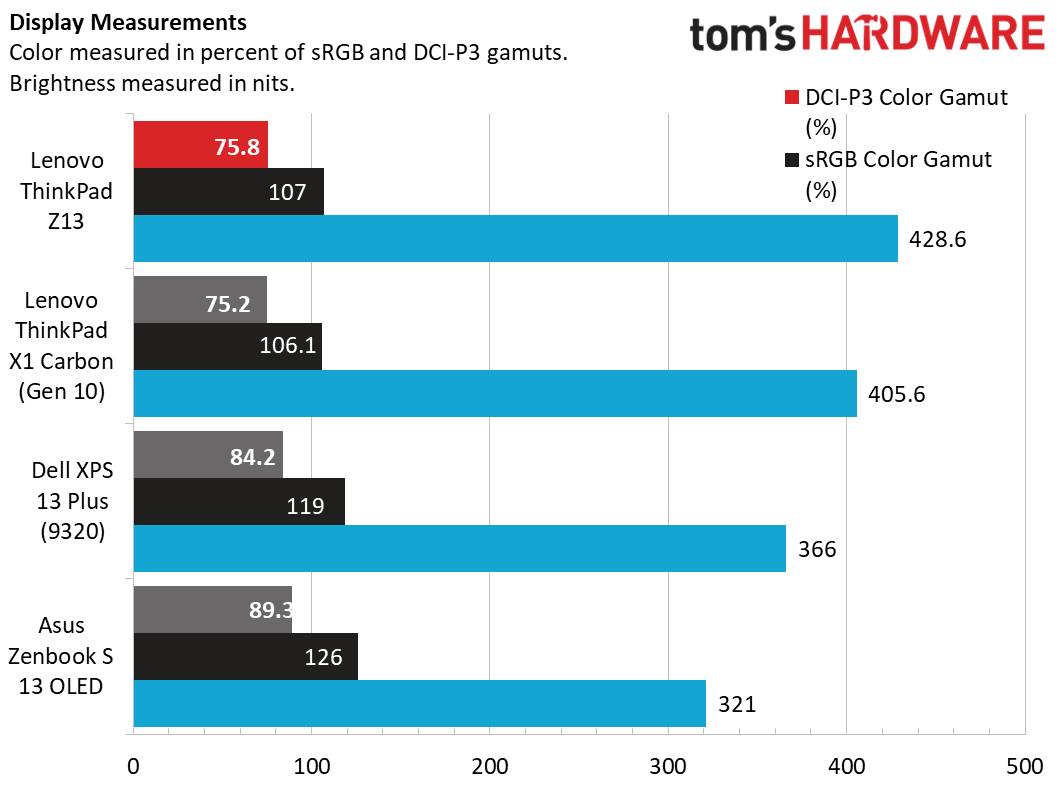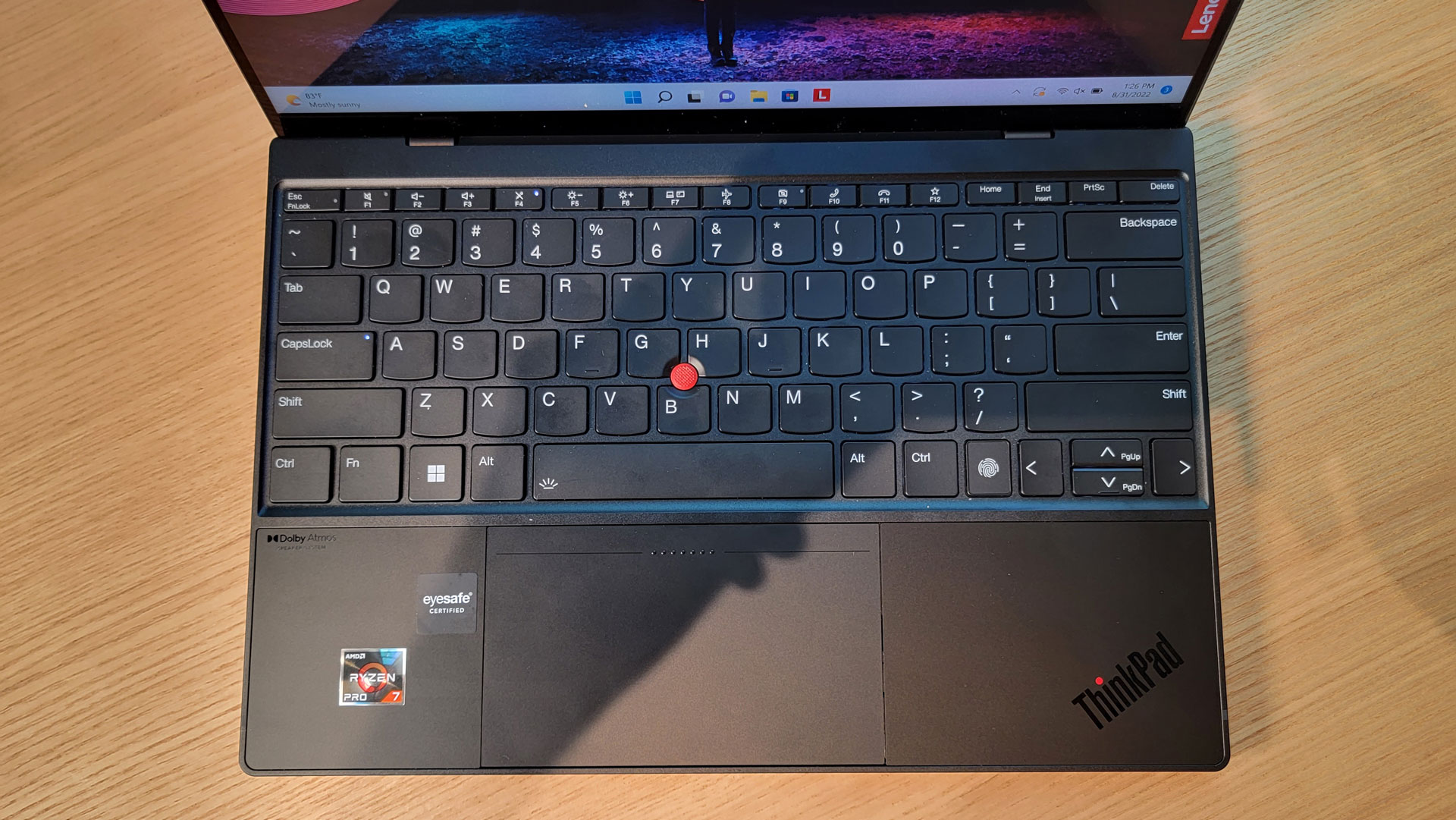Tom's Hardware Verdict
The Lenovo ThinkPad Z13 is a sleek, premium PC design with AMD components, great battery life and a faux-leather cover that modernizes the ThinkPad for the 2020's. But its components don't always compete well with rivals.
Pros
- +
Attractive redesign
- +
Phenomenal battery life
- +
Haptic touchpad is fantastic
- +
Bright display
Cons
- -
Mixed performance
- -
Runs hot to the touch under heavy loads
Why you can trust Tom's Hardware
The Lenovo ThinkPad Z13 ($1,355.40 to start, $1,851.85 as configured) isn’t the ThinkPad you remember. Lenovo's black, boxy design is iconic (and often shows up on our list of the best ultrabooks). But after 30 years of ThinkPads, Lenovo is mixing things up with the new Z-series, utilizing minimal ports, vegan leather and AMD chips.
There are lots of little upgrades as well. An updated touchpad gets haptic feedback, and a “communications bar” houses a 1080p camera with IR functionality and dual microphones. It all sticks to the ThinkPad ethos, but feels more modern.
Although all the new inclusions may surprise diehard ThinkPad fans, many of the design choices are incredibly slick, adding functionality while making the Z13 incredibly attractive.However, the AMD Ryzen Pro chip inside didn't always offer stellar performance in our tests.
Design of the Lenovo ThinkPad Z13
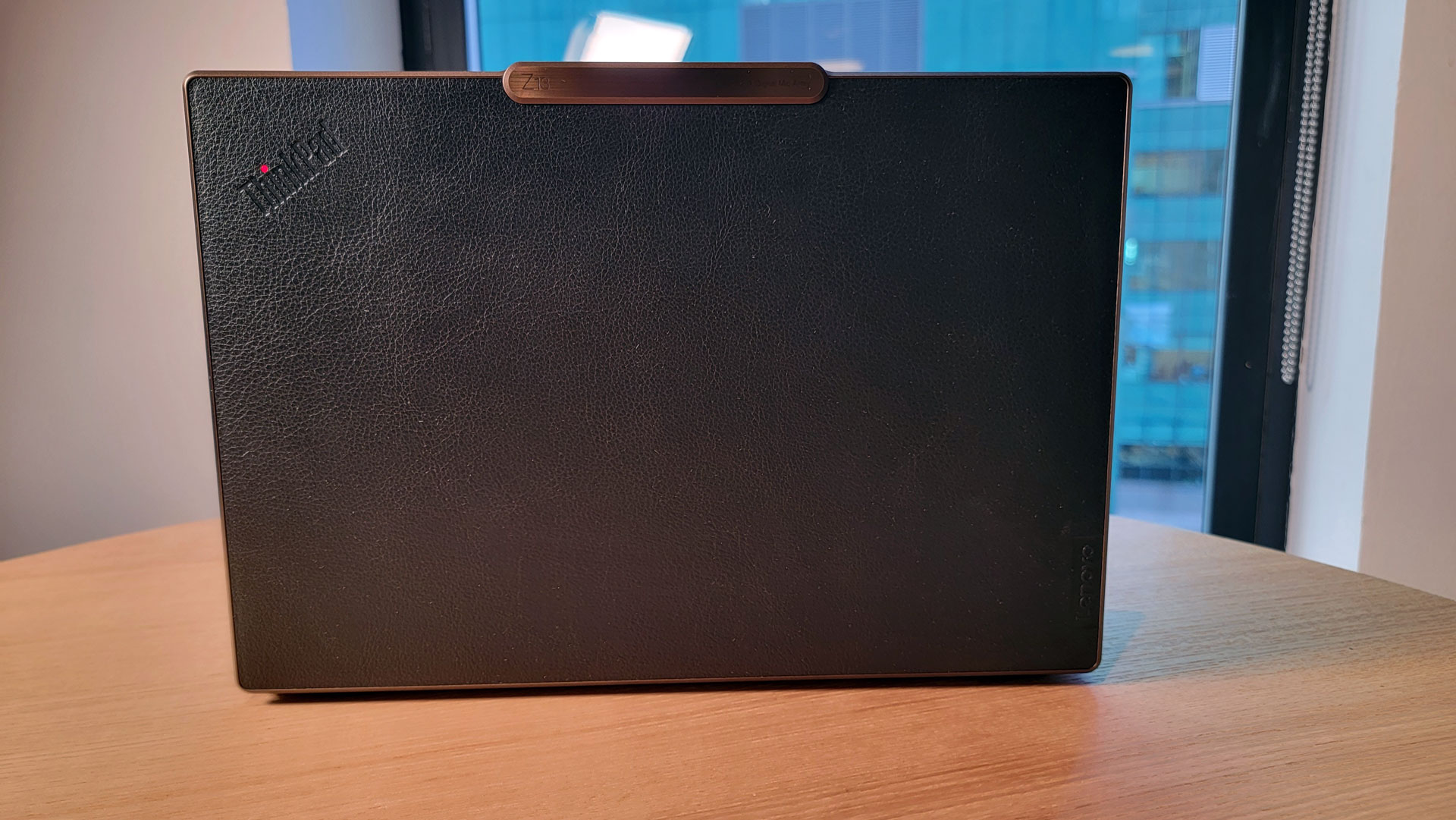
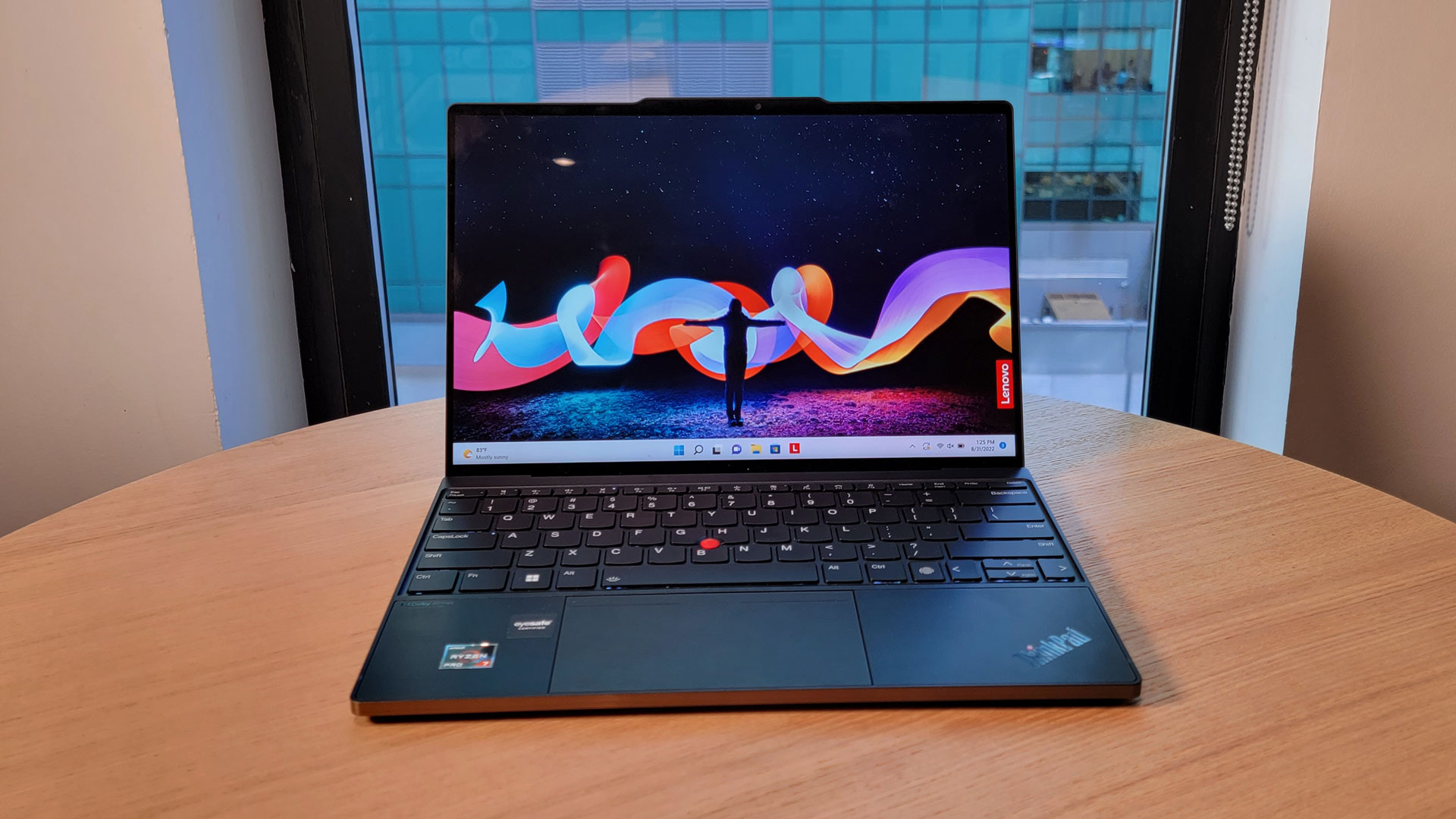
The Lenovo ThinkPad Z13 has a minimalist design made with 95% recycled aluminum and, in our review unit, vegan leather from recycled water bottles. (This isn't Lenovo's first rodeo with leather, though it has switched to a faux material here, which is optional.)
The design is sleek and attractive. The lightweight chassis utilizes a bronze brushed metal finish made with recycled metal, The vegan leather lid is only available for one Z13 configuration, which is the one we tested; Otherwise, you get a gray aluminum lid. Although the vegan leather seems durable and adds to the overall premium feel of the device, at the time of this writing, it costs $45 extra. The lid sports ThinkPad branding on the bottom-right corner next to its classic dotted "i." The bottom of the laptop has three feet, with two down-firing speakers on the edges. Unfortunately, the metal finish allows for many smudges and fingerprints on the bottom–which might be the best argument for paying a little extra for fake leather.
The raised communications bar, which houses the webcam and dual microphone, protrudes enough above the screen to work as a handle to lift the laptop open. Once revealed, you'll see that the inclusion of the raised bar allowed Lenovo to decrease the bezel around the rest of the Z13’s display.
The deck houses an edge-to-edge keyboard with two-level backlighting and a classic red TrackPoint between the G,H and B keys. There is also a spacious all-glass touchpad that uses haptic feedback to respond to your clicks. The Z13 doesn't have dedicated buttons for TrackPoint users above the touchpad the way many previous ThinkPads have. Nub aficionados will have to use a spot on the top of the haptic touchpad.
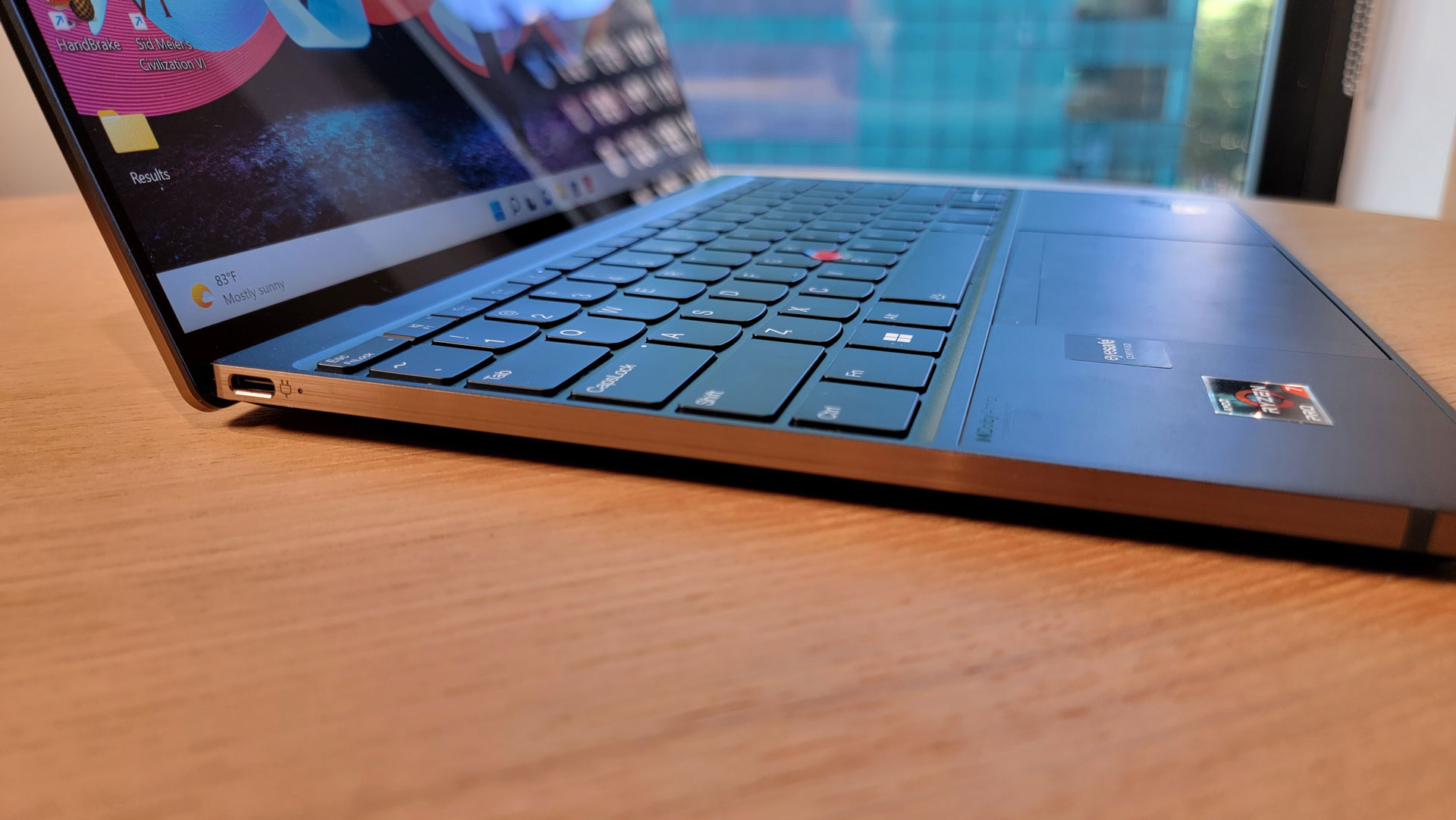

There is a USB 4 Type-C port on each side of the laptop, which lets you charge easily and keeps peripherals from bumping up against each other. The right side also has a 3.5 mm headphone jack. This is not a ton of ports for a business notebook, but it's on trend with what's happening in the ultraportable space.
Get Tom's Hardware's best news and in-depth reviews, straight to your inbox.
The ThinkPad Z13’s new minimalist design is light and compact compared to similar notebooks. The Z13 is 11.59 x 7.86 x 0.55 inches and 2.78 pounds. Lenovo’s flagship Intel business laptop, the ThinkPad X1 Carbon (Gen 10), has a 12.43 x 8.76 x 0.60-inch footprint at 2.48 pounds, making it slightly lighter than the Z13. The Dell XPS 13 Plus comes in at 11.63 x 7.84 x 0.60 inches and 2.77 pounds, while the Asus Zenbook S 13 OLED measures 11.68 x 8.29 x 0.59 inches and 2.43 pounds.
Lenovo ThinkPad Z13 Specifications
| CPU | AMD Ryzen 7 Pro 6850U |
| Graphics | AMD Radeon 680M Graphics (integrated) |
| Memory | 16GB LPDDR5-6400MHz |
| Storage | 512 GB PCIe SSD |
| Display | 13.3-inch 1920 x 1200 IPS, 60Hz, 16:10 touchscreen |
| Networking | Lenovo ThinkPad Z13 (Qualcomm WCN685x Wi-Fi 6E) |
| Ports | 2x USB 4 Type-C, 3.5 mm headphone jack |
| Camera | 1080p |
| Battery | 51.1 Whr |
| Power Adapter | 65 W |
| Operating System | Windows 11 Home |
| Dimensions (WxDxH) | 11.59 x 7.86 x 0.55 inches (294.4 x 199.6 x 13.99 mm) |
| Weight | 2.78 pounds / 1.26 kg |
| Price (as configured) | $1,851.85 (as configured) |
Productivity Performance on the Lenovo ThinkPad Z13
We tested the Lenovo ThinkPad Z13 with an AMD Ryzen 7 Pro 6850U, an eight-core, 16-thread processor with a 2.7-GHz boost clock and a 4.7-GHz base clock. Lenovo does offer an exclusive U-series processor from AMD called the Ryzen 7 Pro 6860Z, also with eight cores and 16 threads, but an ever-so-slightly higher 4.73-GHz max boost. The Z13 we reviewed also sported 16GB of LPDDR5 RAM and a 512 GB SSD.

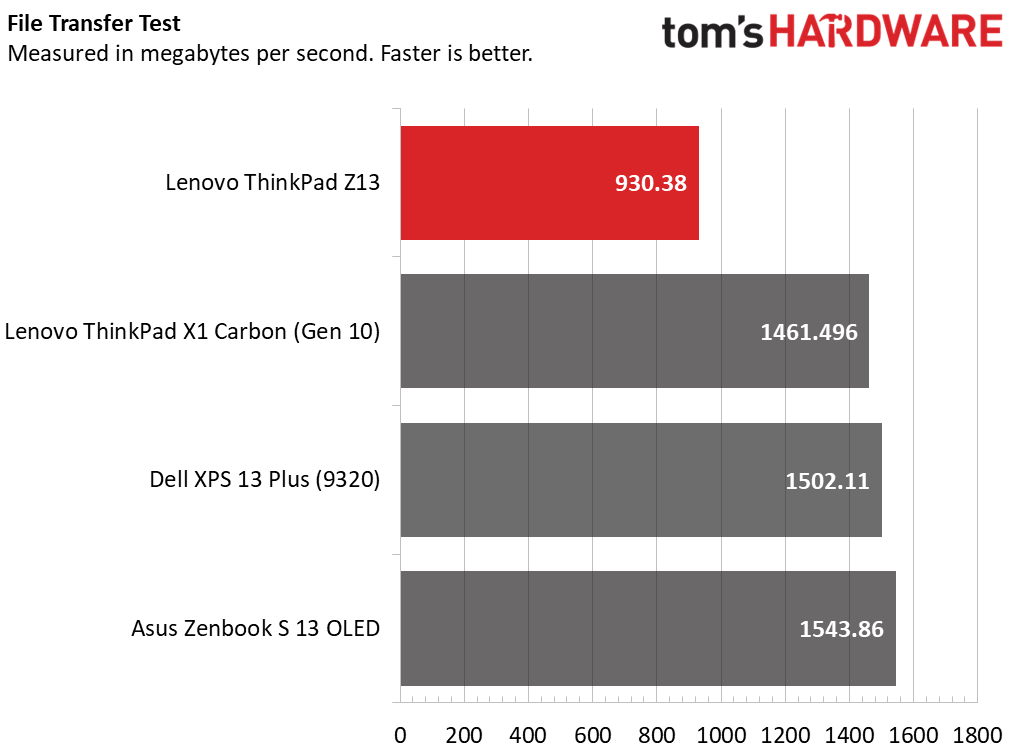
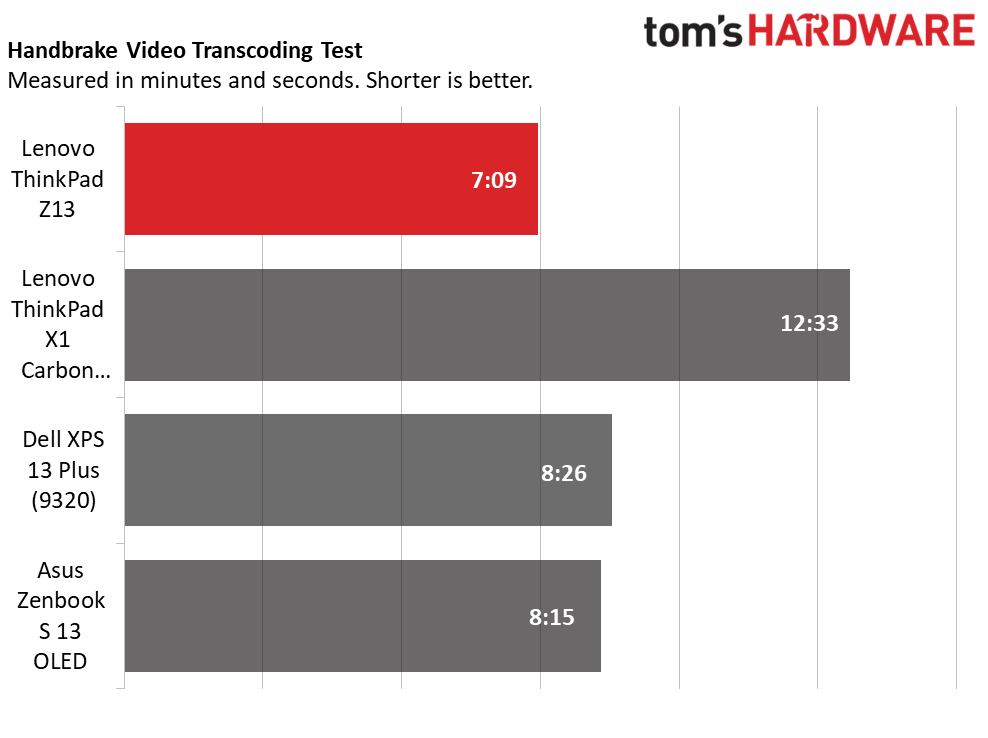
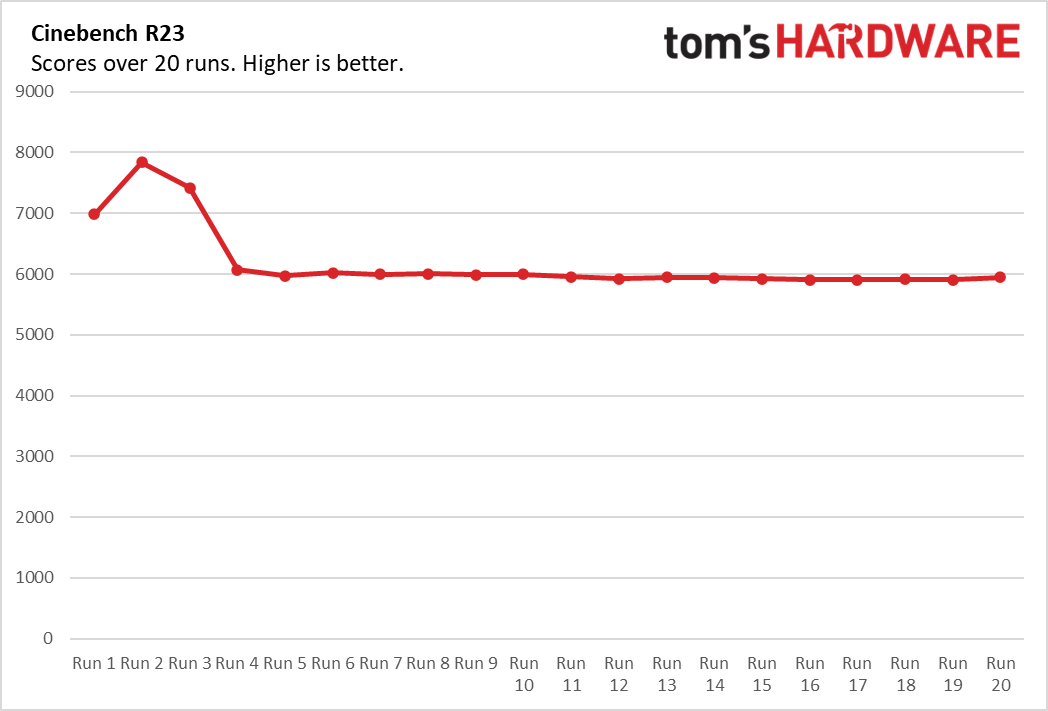
On Geekbench 5, an overall performance benchmark with heavy CPU focus, the ThinkPad Z13 notched a single-core score of 1,501 and a multi-core score of 8,768. In some cases, it lost out to Intel-based notebooks using 12th Gen P-series processors.
Lenovo’s flagship business laptop, the ThinkPad X1 Carbon (Gen 10) with its Intel Core i7-1260P had a 1,644 single-core score and an 8,159 multi-core score, winning in the former but coming behind in the latter. The Dell XPS 13 Plus (Intel Core i7-1280P) had the best performance overall, with 1,797 single-core and 10,621 multi-core scores. The Asus ZenBook S 13 OLED’s Ryzen 7 6800U showed similar performance to the Z13, albeit with a slightly weaker multi-core score.
The Z13 was also the slowest to duplicate 25GB of test files, at a rate of 930.38MBps. It didn’t hold a candle to other competitors, all of which were roughly in the same ballpark of 1,500 MBps, with the Zenbook S 13 edging out as the fastest.
On our Handbrake test, we have laptops transcode a video from 4K to 1080p. The Z13 performed this task in 7 minutes and 9 seconds, the fastest of the bunch. The X1 Carbon (Gen 10) took the longest at 12:33, while the XPS 13 Plus completed the task in 8:26 and Zenbook finished in 8:15.
To see how productivity notebooks handle long computing tasks, we run the Cinebench R23 benchmark 20 times in a row. The Z13 started at 6,985.69, somewhat oddly hopped up to 7,840.55, and then dropped down and settled in the high 6,000 range. For comparison, the Dell settled around the low 6,000's while the Zenbook stayed in the low 9,300's.
During the Cinebench R23 runs, the CPU operated at an average of 2.3 GHz, with an average temperature of 69 degrees Celsius (156.2 degrees Fahrenheit).
Display on the Lenovo ThinkPad Z13
The display on the Lenovo ThinkPad Z13 is 13.3-inches, with a 1920 x 1200 resolution in our configuration, 60 Hz refresh rate and a 16:10 aspect ratio. When I watched Goodfellas on the Z13, I was shocked by how impressive the picture quality was. Even though our review unit didn't have an OLED panel like some other Z13 configurations, during the opening scene, the reds from a car’s backlight were vibrant, and the polished old-school vehicles during the following opening montage shined especially brightly.
The display has very slim bezels around the screen. With a 16:10 aspect ratio, there’s some extra real estate for productivity because the screen is taller than the common 16:9 ratio.
The Lenovo ThinkPad Z13’s panel covers 75.8% of the DCI-P3 color gamut and 107% of the sRGB gamut. The Dell XPS 13 Plus and Asus Zenbook S 13 OLED surpassed the Z13 in both color gamut measurements, and the Lenovo ThinkPad X1 Carbon (Gen 10) had roughly the same measurements as the Z13. However, the Z13 has the brightest display of the bunch with 428.6 nits on our light meter. The X1 fell behind it with 405.6 nits, followed by the XPS 13 Plus at 366 nits and the Zenbook with 321 nits.
Keyboard and Touchpad on the Lenovo ThinkPad Z13
The keyboard on the ThinkPad Z13 is completely usable, but I wish it had a bit more feedback. It's spaced out well, but the keys, while offering plenty of travel, have only a slight thump when you press down. I expect a bit more tactility from a ThinkPad keyboard. When I tested my typing skills on 10fastfingers, I scored 61 words per minute (wpm) with a 97.12% accuracy. That’s in the ballpark of the 60-wpm score I usually get typing on laptops.
Lenovo includes its classic TrackPoint pointing system at the center of the keyboard and a well-placed fingerprint reader next to the arrow keys (which works well). If you double tap the red dot, the TrackPoint QuickMenu launches, which allows you to adjust the microphone, dictate or mute on the fly, a feature you don’t find on other ThinkPads Unlike with other ThinkPads, there are no discrete TrackPoint buttons. You have to tap the top of the touchpad, which itself is haptic with no physical button press.
The touchpad on the Z13 felt great. Lenovo calls it a Haptic ForcePad. The all-glass surface eliminates dead zones, making it possible to click anywhere on the touchpad, even up near the top. The feature, alongside its sensitivity, can be toggled or adjusted in Windows Settings and the TrackPoint Menu. At a spacious 4.7 x 2.6 inches, I could execute gestures and track the cursor with ease. This was one of the more memorable touchpad experiences I’ve had reviewing or using laptops.
Audio on the Lenovo ThinkPad Z13
The audio on the Lenovo ThinkPad Z13 is surprisingly fantastic; the two down-firing speakers on the bottom are powerful. While watching Goodfellas, I was pleased by how clearly I could hear De Niro, Pesci, and Liotta’s conversation as they were burying a body. After the latter closed the trunk of the car and “Rags To Riches” started playing, the sound quality was akin to what I expect from a TV.
When I listened to music on Spotify, the Z13’s speakers performed well with the included Dolby Atmos software. Without it though, things didn’t sound as good.
Upgradeability of the Lenovo ThinkPad Z13
There are five Torx screws along the edges of the Lenovo ThinkPad Z13. After unscrewing them, I needed a pry tool to pop the lid off. Once I opened it, I noticed that the laptop's battery was accessible, as was its networking card. The sole SSD slot is behind a copper heat shield, and is only compatible with a short 2450 M.2 SSD. The RAM is soldered into the motherboard.
Battery Life on the Lenovo ThinkPad Z13
The Lenovo ThinkPad Z13 has extraordinary battery life. During our battery benchmark, which continually browses the web, streams video, and runs OpenGL test over Wi-Fi at 150 nits of brightness, the Z13 lasted 13 hours and 58 minutes.
The Zenboook S 13 OLED, another Ryzen 6000-based machine, was the closest to rivaling the Z13 at 11:02. The XPS 13 Plus and ThinkPad X1 Carbon (Gen 10) lasted 7:34 and 8:48, respectively. Although not as strong as last year's ThinkPad X1 Carbon (Gen 9) and its 15-and-a-half-hour battery life, the Z13 is pretty close. And although the Z13 can last just about the whole day, the 65W power brick takes up little space during travel.
Heat on the Lenovo ThinkPad Z13

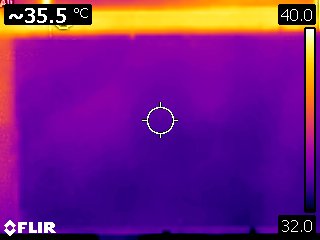
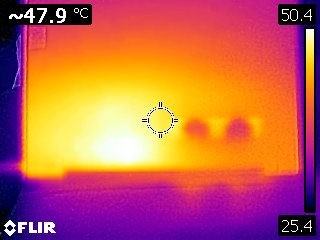
The ThinkPad Z13 got a bit toasty during our stress testing. When we ran Cinebench R23 , the keyboard ended up being the hottest point on the machine.
As usual, the touchpad was the coolest at 95.9 degrees Fahrenheit, but the temperature between the G and H keys was 122.9 degrees Fahrenheit and was hot to the touch. The underside, usually the hottest part of a laptop, was a few degrees lower than the keyboard, at 118.22 degrees Fahrenheit.
On the bright side, the system stays pretty cool when not under load. After we streamed a video for 15 minutes, the middle of the keyboard measured 91.5 degrees Fahrenheit, the touchpad hit just 83 degrees and the bottom measured 95.5 degrees.
Inside, there’s a vapor chamber thermal solution co-developed by AMD that’s meant to keep the unit cool and sustain performance under heavy operations, but there’s clearly room for improvement. If you’re doing heavy work on the Z13, it’d be best to set it on a desk.
Webcam on the Lenovo ThinkPad Z13
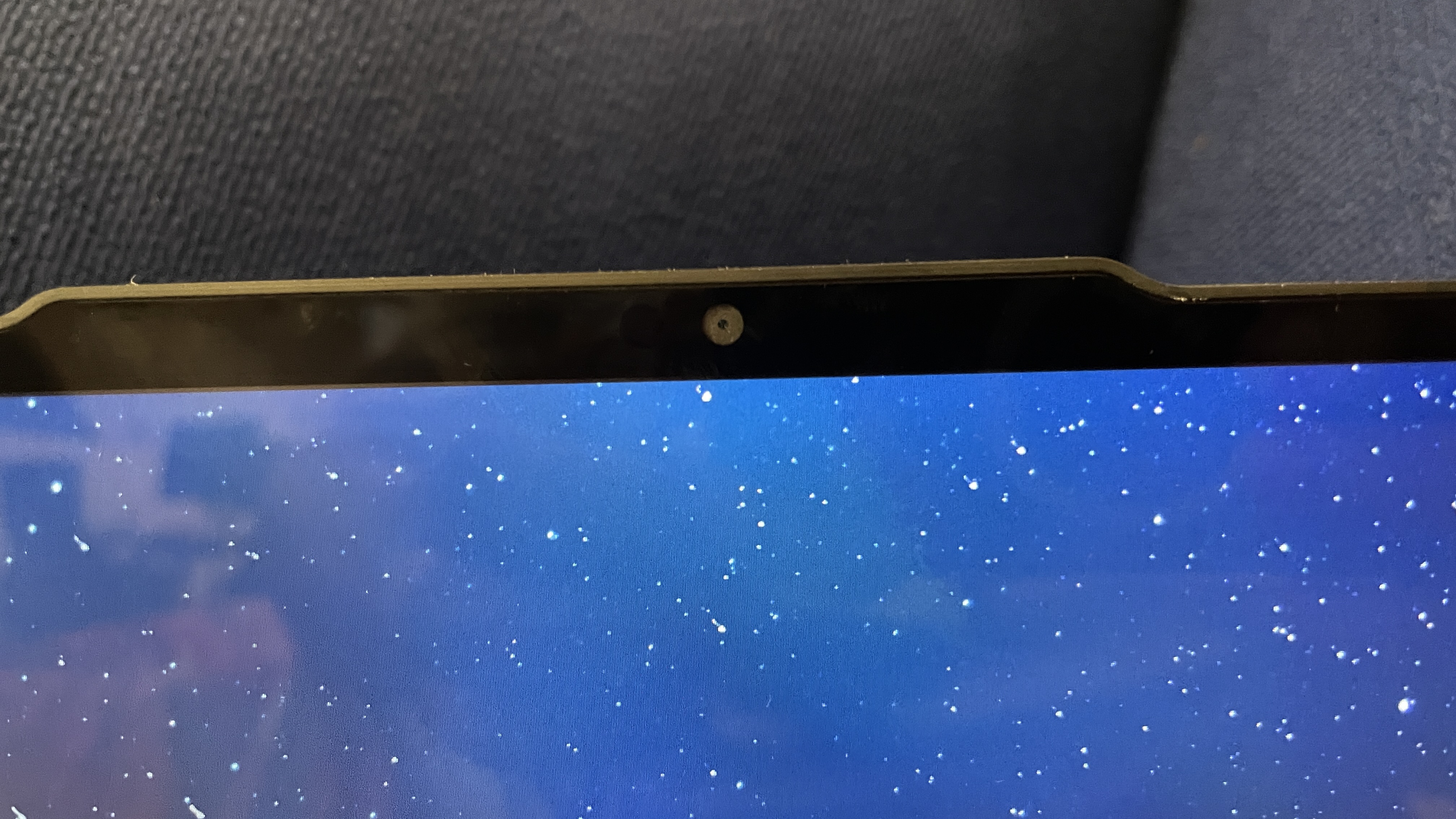

The webcam on the Lenovo ThinkPad Z13 leaves a bit to be desired, even though it’s a generous 1080p. The Z13 has a “communications bar” on top of the display that houses dual-array microphones and a large sensor FHD camera, with IR functionality for facial recognition. The webcam clearly made out my Batman poster and all its lettering in the background, but I didn't appear as detailed in the foreground.
There was very little detail in my hair or face, and the image didn’t accurately capture my skin tone.
With that said, like most laptops, the webcam doesn't match the abilities of cameras on our best webcam list. However, it does feature facial recognition for Windows Hello and has an e-shutter on the F9 key to turn it off instantly.
Software and Warranty on the Lenovo ThinkPad Z13
The Lenovo ThinkPad Z13 is very light on preinstalled software, including the usual Windows apps we see. Commercial Vantage offers easy access to your warranty information and serial number, and Lenovo Pen lets you customize settings if you use a stylus.
Lenovo View lets users adjust light, color, and intensity to improve video quality, but it doesn’t really improve things much. Glance by Mirametrix uses the Z13’s IR sensors to change the camera’s height, provide wellness checks based on posture, and offer various video conferencing features.
There were only a few preloads from Microsoft on our unit, including Disney Plus, Spotify, and Netflix.
The Lenovo ThinkPad Z13 comes with a 1-year onsite warranty, but it can be extended for an added cost.
Lenovo ThinkPad Z13 Configurations
Our configuration of the Lenovo ThinkPad Z13 came with a Ryzen 7 Pro 6850U, 16GB of LPDDR5 RAM and a 512GB SSD. It also has a 13.3-inch display with a 1920 x 1200 resolution, 60 Hz refresh rate and a 16:10 aspect ratio. Ours also had the vegan leather top cover, putting the price at $1,851.85.
The ThinkPad Z13 starts at $1,355.40 with a Ryzen 5 Pro 6650U, 16GB of RAM, 256GB of storage and a non-touch screen, as well as the aluminum top cover.
Lenovo's most expensive pre-configured unit has the Ryzen 7 Pro 6860Z, 32GB of RAM, 1TB SSD and a 2880 x 1800 OLED touchscreen for $2,267.85. This version also doesn't have the vegan leather top cover, which appears to be tied to certain configurations.
Lenovo's prices on its website do seem to rotate often due to sales, so it's possible prices will shift a bit from what we saw.
Bottom Line
The Lenovo ThinkPad Z13 is an attractive new business laptop with a minimalist design and the option for exclusive AMD Ryzen hardware. Although we didn’t have the OLED version to test, the edge-to-edge 16:10 display is still impressive. It also has a new comfortable touchpad with haptic functionality and fantastic battery life that will last an entire work day.
The ThinkPad Z13 does get a bit toasty, and mixed performance keeps this from being the best ThinkPad on the block. But this is a decent first outing for a new generation of ThinkPad from Lenovo, and hopefully these new design choices continue through to future models.
If you want long battery life and are willing to give up top-notch performance to get there, the Z13 is worth seriously considering, especially if you like its good looks. Those who want more power or a bit more traditional should stick closer to the X1 Carbon, though you'll give up some battery life if you go that route.

Isaac Rouse is a staff writer at Tom's Hardware. He reviews laptops and various gaming peripherals.
-
Bikki I keep saying this but where is the (light) gaming benchmark, especially here we're dealing with ryzen 6000 system with zen 3 and rdna 2 that supposedly more powerful than a steam deck.Reply -
OmegaMalkior Made an account just to say this, but the ThinkPad Z13 G1 does NOT have vapor chamber cooling, much less, "co-developed" by AMD. I have absolutely no clue where this information came from, but no one has ever said this laptop has a vapor chamber of all things. The only other person to have said this was LinusTechTips, and I can bet they got it from this exact lone review that mentions it. The black shroud that cover the heatpipes are just paper and not an actual vapor chamber as it appears to be. You can Google info on this and not even Lenovo's spec sheet will show vapor chamber cooling. And heck, not even the ThinkPad Z16 with an RX 6500M has it, so the Z13 would get it even less.Reply
